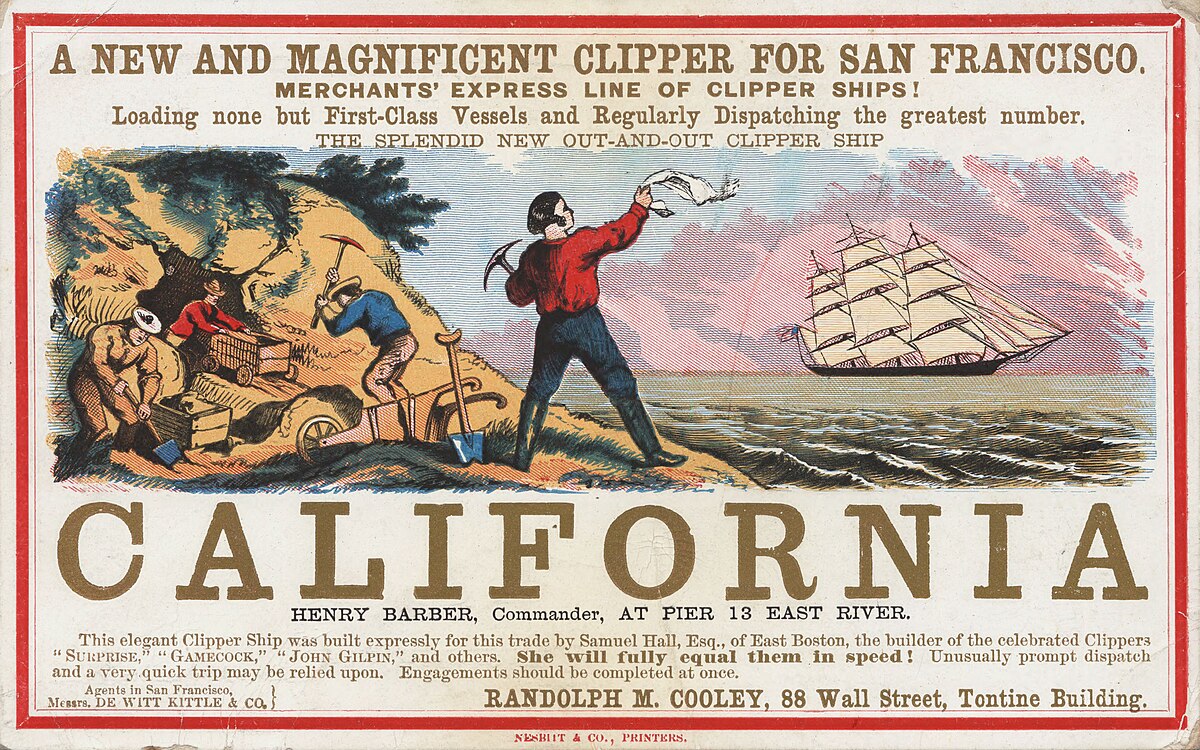The California Gold Rush had major effects on California's population boosting it from the pre- 1848 number of 1000 to over 100,000 by the end of 1849. It is estimated that a total of $2 billion of precious metals were removed from the ground during the entirely of the Gold Rush. The starting point of the Gold Rush can be traced to James Wilson Marshall, a New Jersey carpenter who found gold flakes in the American River near Coloma, California. Living in the colony of New Switzerland, the population soon became so prominent that it would become Sacramento. Right after the discovery of Gold at Sutter's Mill, the Treaty of Guadalupe Hidalgo was signed and California was now under the jurisdiction of the United States. Although both Marshall and his boss, John Sutter attempted to keep the news of gold on the down-low, word got out and newspapers printed the news- shocking the people in San Francisco. As a result, 3/4 of San Francisco's male population left to go work into gold mines. Once the word spread to the east coast and was confirmed by the president, men mortgages their properties, loaned money, and made the trip to California. These men were called "49ers". As a result of these male populations coming to California, towns were built- with saloons, brothels, shops and more. The overpacked camps and such grew lawless: "banditry, gambling, prostitution, and violence"(www.history.com) were not uncommon. Thanks to the Gold Rush, California was admitted into the Union through the Compromise of 1850. Although the amounts of gold gradually decreased, many miners then saw this as an opportunity to switch into wage labor jobs and continue living within the state.
But, what technologies made gold mining possible?
1) Panning for Gold: The most basic method to get gold. Bits of gravel from a river bed were put into a pan with water, and the mixture would be swished around so the water and light airy sediments would fall over the side. The more weighty gold would stay at the bottom. This was, however, a tedious process. "On a good day, one miner could wash about 50 pans in the usual 12-hour workday and obtain a small amount of gold dust" (sierracollege.edu)
2) Rocker or Cradle: A rectangularly shaped wooden box, the rocker would be put on a rocking chair like machine. The hand would move the cradle, and big rocks would get stuck in the sieve and heavier gold clumps would fall to the bottom of the box. It was easily moveable, but it could not catch the small gold powder/
3) The Long Tom: Basically like a rocker, but had a 10-20 foot trough. A couple men shoveled dirt and gravel on the Long Tom, another person got rid of the bigger rocks, and then the gold and sand caught on the "riffles" below would get panned. It needed a source of swift moving water continuously so was not necessarily advantageous if it needed to be moved to a differnt area with no river.



Sources:
http://www.history.com/topics/gold-rush-of-1849
https://www.sierracollege.edu/ejournals/jsnhb/v2n1/miningtechniques.html
Anya, I liked your description of how the Gold Rush resulted in California being admitted to the Union as well as your explanation of the techniques employed by miners. You mentioned how in a 12-hour workday, most miners could only obtain a small amount of gold dust, so one question I had was why people from the East were so eager to make the journey westward to attempt to find gold when in reality they were not likely to find much at all. Were they unaware of the scarcity of gold, simply overly optimistic, or did some other factor cause this migration?
ReplyDeleteI really liked your use of images in this article; I think it really helped with picturing what the specific methods to mining gold looked like back then. I think it's particularly compelling to me to learn about what events might have inspired the creation of California as a state, the California Gold Rush of being one. It's interesting that you mentioned certain technologies that made mining for gold possible, but that all three were tedious and had little return for the amount of effort required to separate the gold from the rest. Were there more technologies that enabled gold mining to occur faster and more efficiently developed in the future?
ReplyDelete